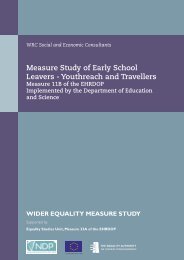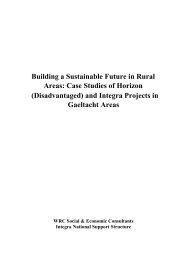Issues and Challenges in the Recruitment and Selection of ...
Issues and Challenges in the Recruitment and Selection of ...
Issues and Challenges in the Recruitment and Selection of ...
You also want an ePaper? Increase the reach of your titles
YUMPU automatically turns print PDFs into web optimized ePapers that Google loves.
first language. The extent <strong>of</strong> <strong>the</strong> difficulty that foreign c<strong>and</strong>idates experience<strong>in</strong> relation to <strong>the</strong> <strong>in</strong>terview process may not be fully appreciated by employers.The value <strong>of</strong> <strong>in</strong>tercultural tra<strong>in</strong><strong>in</strong>g <strong>of</strong> <strong>in</strong>terviewers is <strong>in</strong>dicated here. In general,employers were more aware <strong>of</strong> <strong>the</strong> difficulties for immigrants associated withwritten tests but few had sought ways to m<strong>in</strong>imise <strong>the</strong>se. The difficulty <strong>in</strong>f<strong>in</strong>d<strong>in</strong>g effective alternatives to test<strong>in</strong>g must be acknowledged <strong>and</strong> at <strong>the</strong> level<strong>of</strong> <strong>the</strong> <strong>in</strong>dividual company, address<strong>in</strong>g this issue may be costly. However, macrolevel approaches <strong>in</strong>clud<strong>in</strong>g ongo<strong>in</strong>g monitor<strong>in</strong>g <strong>and</strong> experimentation should beconsidered.Measures to smooth <strong>the</strong> vett<strong>in</strong>g process – <strong>in</strong>clud<strong>in</strong>g <strong>in</strong> relation to references,police clearance, recognition <strong>of</strong> qualifications <strong>and</strong> legal entitlement to work –need to be put <strong>in</strong> place. Greater support for employers <strong>in</strong> terms <strong>of</strong> <strong>in</strong>formation<strong>and</strong> assistance is required, as is better communication <strong>of</strong> ongo<strong>in</strong>g legislativechanges <strong>and</strong> easier access to sources <strong>of</strong> <strong>in</strong>formation.If <strong>the</strong> requirement to have work experience <strong>in</strong> Irel<strong>and</strong> is operat<strong>in</strong>g as a significantbarrier, particularly for highly skilled applicants, it would po<strong>in</strong>t to clear remedies<strong>in</strong> terms <strong>of</strong> <strong>in</strong>novative work experience programmes for immigrants (<strong>in</strong>clud<strong>in</strong>grefugees).4.5 ConclusionLook<strong>in</strong>g at <strong>the</strong> issue <strong>of</strong> immigration <strong>in</strong> <strong>the</strong> round - tak<strong>in</strong>g <strong>in</strong>to account, forexample, <strong>the</strong> need to ma<strong>in</strong>ta<strong>in</strong> competitiveness, to attract <strong>and</strong> reta<strong>in</strong> adequatelyskilled <strong>in</strong>dividuals, to ensure that <strong>the</strong> legislative <strong>and</strong> socio-economic contextsare supportive <strong>of</strong> immigrants, <strong>and</strong> <strong>the</strong> need to meet <strong>the</strong> requirements <strong>of</strong> <strong>the</strong>country <strong>of</strong> orig<strong>in</strong> (as <strong>in</strong> <strong>the</strong> case <strong>of</strong> Indian nationals <strong>and</strong> <strong>the</strong> transferability <strong>of</strong>social security entitlements for repatriated migrants) etc. – it would appear, <strong>in</strong>conclusion, that <strong>the</strong> f<strong>in</strong>d<strong>in</strong>gs <strong>of</strong> this research are likely to become not less butmore important <strong>in</strong> <strong>the</strong> future. As previously noted, <strong>the</strong> emphasis on diversityto date from an Irish perspective has centred on <strong>the</strong> management <strong>of</strong> diversitythat exists <strong>in</strong> <strong>the</strong> workforce <strong>and</strong> not to <strong>the</strong> same degree on <strong>the</strong> accommodation<strong>of</strong> diversity <strong>in</strong> <strong>the</strong> recruitment <strong>and</strong> selection processes that effectively ‘control’<strong>the</strong> resultant diversity <strong>in</strong> <strong>the</strong> workforce <strong>of</strong> any organisation. In <strong>the</strong> future <strong>the</strong>emphasis is likely to lie <strong>in</strong> our capacity to attract people to work <strong>in</strong> Irel<strong>and</strong>.As previously noted, Irel<strong>and</strong>’s experience <strong>of</strong> <strong>in</strong>ward migration is still a relativelynew phenomenon. To date that experience has been largely unproblematicdespite <strong>the</strong> dramatic scale <strong>of</strong> <strong>in</strong>ward migration <strong>and</strong> this can <strong>in</strong> part be attributedto <strong>the</strong> economic <strong>and</strong> employment growth achieved over <strong>the</strong> last decade. However,<strong>the</strong> national <strong>and</strong> <strong>in</strong>ternational contexts have changed <strong>and</strong> <strong>the</strong> State (<strong>in</strong>clud<strong>in</strong>g75




